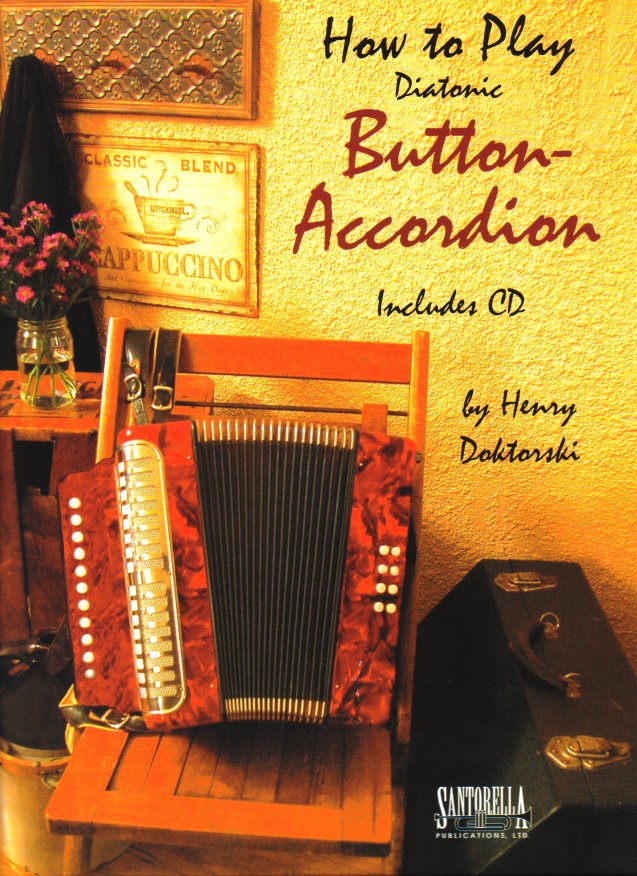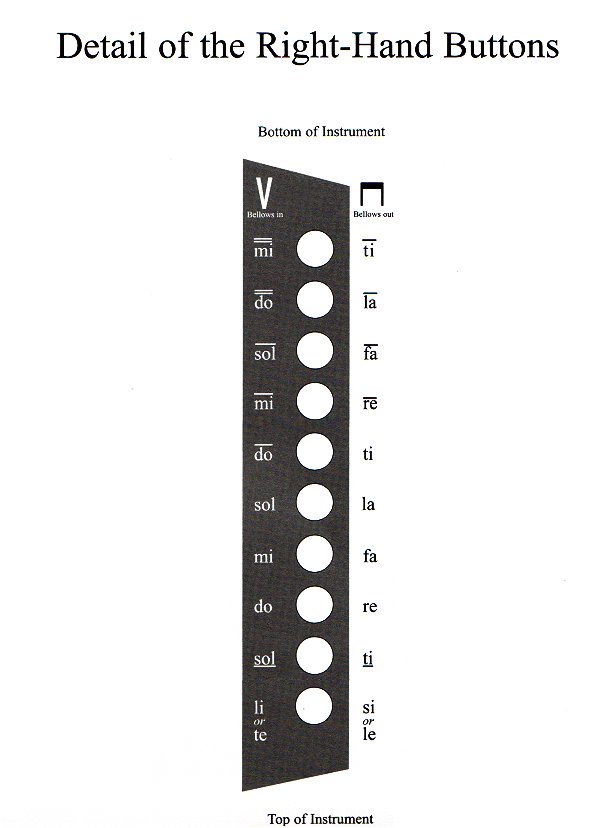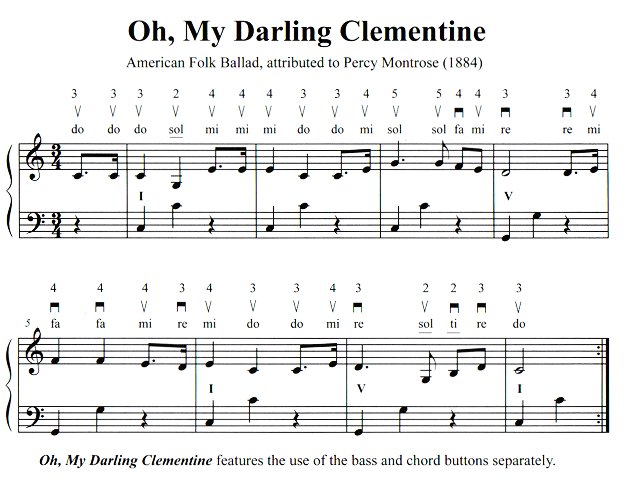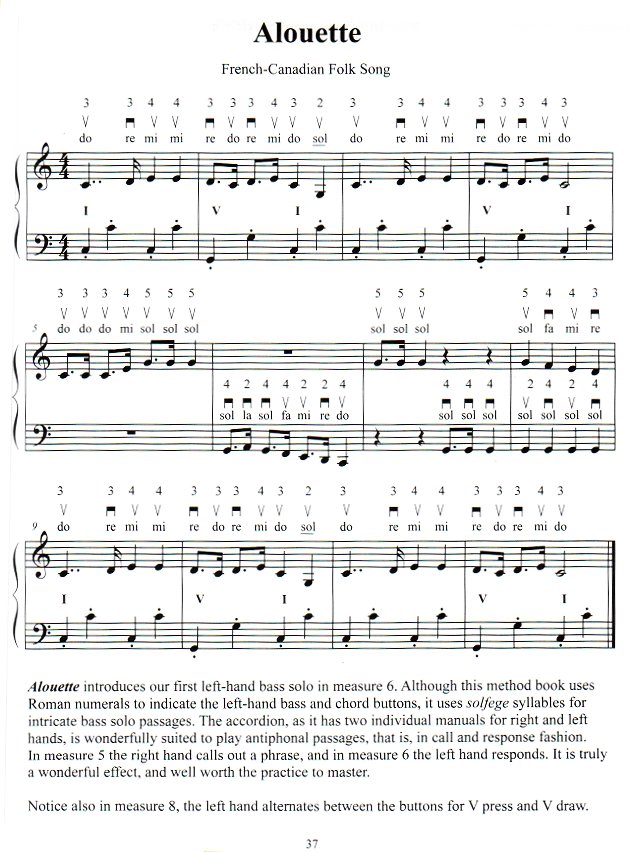How to Play Diatonic Button Accordion, Vol. 1
by Henry Doktorski

Method Book and CD: How to Play Diatonic Button Accordion, Volume 1 (An Easy-To-Follow Guide for Beginners) by Henry Doktorski. Published by Santorella Publications, Ltd. (2007). 48 pages. Measures 9 x 12 inches. Professional High Quality Printing. Includes button charts and diagrams, photographs, including photos of historic accordions and an 1866 print. CD contains all music in the book played by Henry on a one-row button accordion.
This method book was written for Henry’s button-accordion classes at the Fairbanks Summer Arts Festival at the University of Alaska, Fairbanks, and has been acclaimed as the most direct and easy-to-follow button-box method. Includes button charts and diagrams, photographs, and a 39-track CD which demonstrates the musical examples in the book.
Introduction
The diatonic button-accordion (diatonic means it can only play in one key; not a chromatic instrument which can play all the sharps and flats like the piano) is a transposing instrument—like many woodwind and brass instruments, such as the clarinet, saxophone, trumpet and French horn. This means that when a clarinetist or a trumpet player plays the note “C” on his or her instrument, another pitch (such as “Bb”) sounds (unlike a piano, which is written in “Concert Pitch,” or “C”).
The button-accordion is also a transposing instrument, as different instruments play in different keys. You can find button-accordions in C, in G, in D; in F and Bb; practically in every key.
Because the diatonic button-accordion is a transposing instrument, a player needs only to learn the fingering and notes for one scale: the C major scale. If he wants to play in another key (on the one-row button-box accordion), he has to pick up another instrument tuned to that key!
This book is unique, as every other button-accordion method I have seen does not recognize the simple fact that the button-accordion is a transposing instrument and all its music can be written in the key of “C.” This greatly simplifies learning the instrument and allows the student to make rapid progress early on.
Note reading is also not necessary to learn how to play the button-box. Indeed some of the greatest button-accordionists play only by ear. Like great jazz performers, this in no way detracts from their ability to create exciting and beautiful music.
Nonetheless, a method book needs some kind of music notation. This book uses the solfege method; assigning the syllables do, re, mi, fa, sol, la, and ti to the seven notes of the major scale. The origin of solfege appeared in India in ancient Vedic texts such as the Upanishads, and was first propagated in the West by the Italian music theorist monk, Guido of Arezzo (ca. 991-1033), the inventor of modern musical notation. In 1965 the syllables do, re, mi, fa, sol, la, and ti were immortalized in the hit movie musical The Sound of Music.
However, modern music notation is also presented along with the solfege syllables for those students who want to learn it.
This method will explain in detail how to play the one-row Italian-style button-accordion. One row is perfectly suitable for playing most popular and folk melodies. In fact, as can be discerned from listening to the enclosed compact disc, it is amazing what sophisticated music can be performed on a one-row diatonic squeezebox. Even students who own two- or three-row instruments will still have to begin by playing only one row.
Although the left hand is not always used by button-box players (some instruments do not even have buttons for the left hand!), the left hand is taught in this method. In the beginning it may be difficult to coordinate both hands together, but with persistent and patient practice, success will most assuredly come.
Henry Doktorski

A page from Henry’s How to Play Diatonic Button Accordion, Vol. 1
Contents
Foreword
The Accordion: A Blow To Music
Introduction
Pitches of the Right Hand
Diagrams of Left- and Right-Hand Buttons
A) Playing in first position; in one bellow direction only (sol-sol).
Taps
Assembly
Reveille
First Call
B) Playing in first position; in two bellows directions (sol-la).
Down in the Valley (sol-fa)
When the Saints Go Marching In (do-sol)
Good Night, Ladies (sol-sol)
Oh My Darling Clementine (sol-sol)
The Itsy Bitsy Spider
Alouette
London Bridge (do-la)
This Old Man
Twinkle, Twinkle, Little Star
Frère Jacque (sol-la)
Pop Goes the Weasel (sol-la)
C) Adding the Left-Hand Accompaniment
Taps
Assembly
Reveille
First Call
Frère Jacque (I chord only)
London Bridge (I and V chords)
Pop Goes the Weasel (adding the IV chord)
Good Night, Ladies (both versions of V)
Oh My Darling Clementine (playing basses and chords separately)
Down in the Valley
The Itsy Bitsy Spider
Twinkle, Twinkle, Little Star
When the Saints Go Marching In (introducing alternating basses)
This Old Man
Alouette (1st bass solo)
D) Playing in the Second Position (adding ti and do).
Row, Row, Row Your Boat (do-do)
On Top of Old Smoky
Drink To Me Only With Thine Eyes
Camptown Races
Come to the Sea (Vieni Sul Mar)
Du, Du Liegst mir im Herzen (ti-do) (2 positions)
Chiapanecas (sol-do) (2 positions)
Minuet No. 1 (ti-do) (2 positions)
Minuet No. 2 (sol-do) (2 positions)

Listen to O My Darling Clementine

Listen to Alouette
Reviews
International Musician: Official Journal of the American Federation of Musicians of the United States and Cananda (January 2008)
If you have your father or grandfather’s Italian-style button-box accordion in your closet collecting dust, there has never been a better time to learn to play. Musician, educator, and composer Henry Doktorski of Local 60-471 (Pittsburgh, Pennsylvania) shows how easy it can be in his book How to Play Diatonic Button-Accordion. An included 39-track CD demonstrates the musical examples in the book and lets you play along.
Richard Jefferson
I am a guitar player, 60 years old and living in Minnesota. Without owning an accordion or ever having played one, I purchased your book, How to Play Diatonic Button-Accordion. It’s a pleasure to see what a good teacher and player can accomplish. I am both encouraged and delighted.
I look through a lot of how-to books, some not so good. Your love of history, care to help the novice with pronunciations, ability to distill information, and rendering of the melodies with such simple grace serve you well. And me.
How to order this CD:
To purchase this item, contact Henry at: 